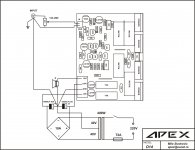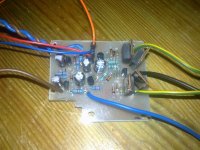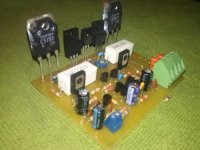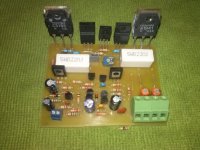You must connect input ground with power ground !
because they are connected through a resistor and a capacitor. simply connect these two wires together?
because they are connected through a resistor and a capacitor. simply connect these two wires together?
Use this schematic.
Attachments
Greetings mr.prasi already i built in apex bx20. Power full sound and i used in pa purpuse it great amp my rail is 65v dc .
nice build!
reg
prasi
because they are connected through a resistor and a capacitor. simply connect these two wires together?
dont connect them on pcb... run seperate wires of i/p gnd and amp gnd to the psu gnd....
edit: i see now, dobrivoje has already posted connection sch. follow that
Last edited:
dont connect them on pcb... run seperate wires of i/p gnd and amp gnd to the psu gnd....
Thanks, I will try 🙂
Here are the files for Apex solid state protection with 8x N-channel MOSFET's.
On the picture you will see earlier 4x MOSFET protect.
Circuit works even from 21V AC . Do not use separate transformer for the protection.
Original and new schematic is included with suggested mods by Apex.
Short-circuit protection doesn't work with NAIM style amplifiers😀, don't even try this circuit on NAIM clones and i think Andrew knows why.
Circuit is the same as in picture + 4 added mosfets in parallel to previous ones.
Important: install TRIAC as showed in picture... faced towards mosfets, not towards bottom.
On the picture you will see earlier 4x MOSFET protect.
Circuit works even from 21V AC . Do not use separate transformer for the protection.
Original and new schematic is included with suggested mods by Apex.
Short-circuit protection doesn't work with NAIM style amplifiers😀, don't even try this circuit on NAIM clones and i think Andrew knows why.
Circuit is the same as in picture + 4 added mosfets in parallel to previous ones.
Important: install TRIAC as showed in picture... faced towards mosfets, not towards bottom.
Attachments
Last edited:
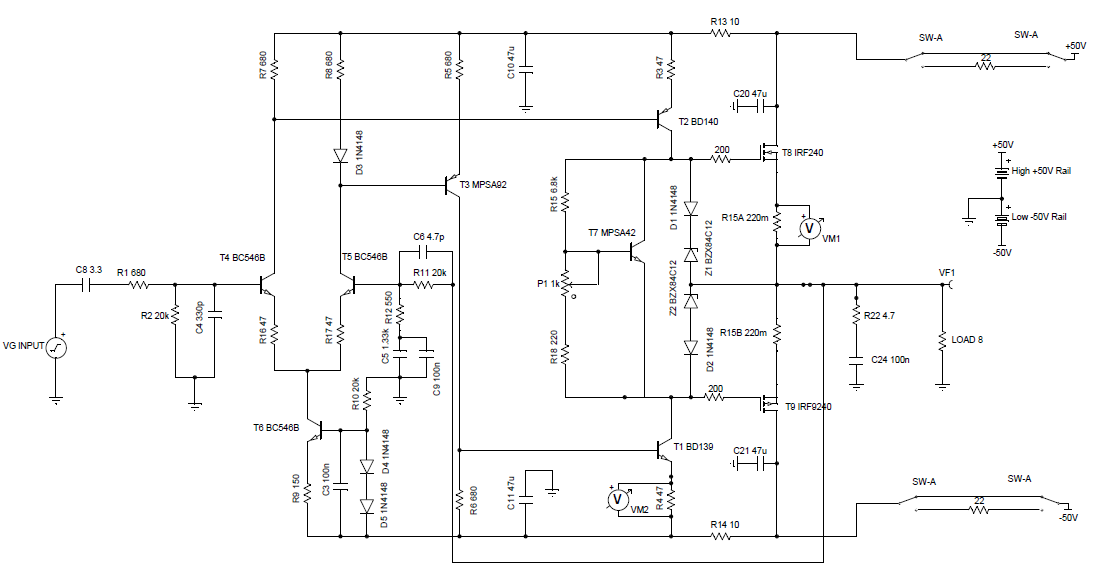
I implemented the above circuit using a small daughter board for the Vbe multiplier with the MPSA42 bolted in between the two output hexFETs. The output devices had to be connected with flying leads as the pinouts are different (S & D swapped on the IRFP240/9240 vs the Hitachi 2SJ/SK's). I used a pair of 10ohm safety resistors in series with the power supply on startup. I adjusted the quiescent bias to 350mA - it likes to run warm. Will have to play with it but so far sound is very good - very powerful sounding and knowing it can take 50v rails is pretty cool.
Here is a closeup of the Vbe multiplier daughter board - the flying leads go to the top and bottom of the bias pot location on the board (removed). The bias current is very stable with this Vbe multiplier acting as a thermal compensator:
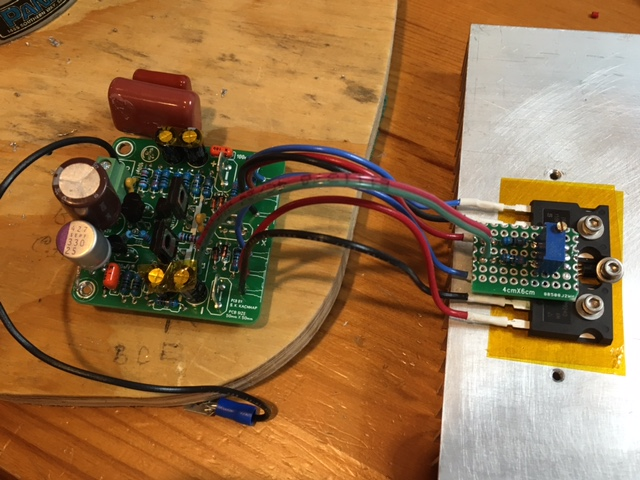
Here are the 0.22ohm source/drain resistors:
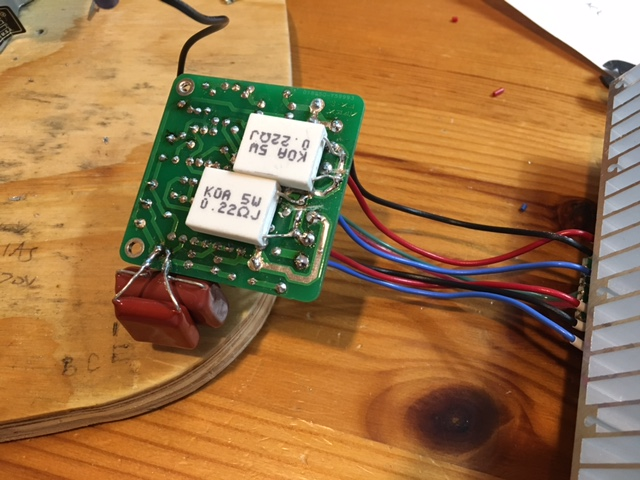
Here is the amp playing music. It's nice when things work like predicted by a sim (nothing blew up and nothing melted). I like it when there is no magic smoke released on first startup 😀:
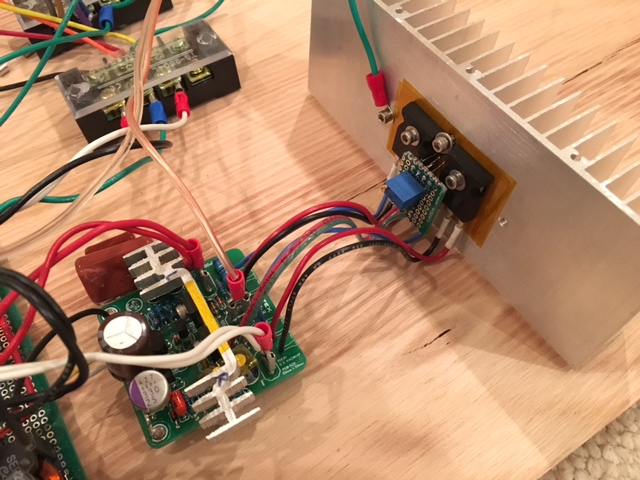
Here are some soundclips of this amp played on a GRS Research XL-S speaker as recorded with a Zoom H4.
Change the .asc extension to .mp3 to listen.
I should note that I am not using the C6 4.7pF feedback cap as shown in the diagram above. Also, I am presently running with +/-35v power supply rails from a 250VA transformer so should be more than enough for now. AndrewT suggested that the max power should be 75w/ch for good reliability so hopefully this supply has enough reserve.
I backed off the bias current to 150mA and it still sounds very good - runs cooler now and I am very happy with this amp. One of the best I have at this point. Still have not had a chance to implement the suggestions by AndrewT yet. Will do that next and also build stereo second channel.
Not sure if folks got a chance to listen to the sound clip but I would like to get your listening impressions.
Thanks,
X
Last edited:
I have a couple questions. Earlier you stated that the sound is better using the Hexfets over the Latfets. What method are you using to compare them? Do you have some sort of A/B setup or are you doing it from memory?
You mentioned a few times that you wanted to use the "cheaper" HexFets. Have you determined what the cost difference is between using the two Latfets vs the two Hexfets including the extra parts required i.e. diodes, VBE multilpier, daughter board etc?
Thanks, Terry
You mentioned a few times that you wanted to use the "cheaper" HexFets. Have you determined what the cost difference is between using the two Latfets vs the two Hexfets including the extra parts required i.e. diodes, VBE multilpier, daughter board etc?
Thanks, Terry
The amplifier works! My feelings - luxurious power, luxurious sound, good looks, I'm happy! Apex AX-14
Congrats!, nothing makes happier than listening to your own creation!
I have a couple questions. Earlier you stated that the sound is better using the Hexfets over the Latfets. What method are you using to compare them? Do you have some sort of A/B setup or are you doing it from memory?
You mentioned a few times that you wanted to use the "cheaper" HexFets. Have you determined what the cost difference is between using the two Latfets vs the two Hexfets including the extra parts required i.e. diodes, VBE multilpier, daughter board etc?
Thanks, Terry
The sound quality is from my listening impressions with base FX8 on left channel and modified on right channel and I switch back and forth but using right input to amp at all times. Of course in mono is all that makes sense.
There is quantitative data in terms of frequency response measurement with calibrated mic at same position with same speaker, only amp changing. It is measurable difference in bass response and lower HD in mids and highs. For some reason, the lateral FETs have a rising distortion from 1k and up. The same board with the mods and hexFETs have lower distortion. This means it might have been rather high to appear at a speaker (>-40dB or 1%). The shape of the response is pretty much the same above 300Hz, with the hexFET more bass response below by about 1.5dB and deeper extension by a few Hz.
I really need an amp distortion analyzer and would like to make a DIY one somehow - suggestions welcome. I am thinking a USB audio digital interface with a resistor voltage divider network and measure signal on dummy resistor load vs a mic?
Regarding cost: MPSA42 is $1.00 for a bag of 50, genuine IRFP240 and IRFP9240 are $4.50 a pair.
latFET are $15/pair
Can i just parallel outputs on fx8 if i want more current or do i need a new vas driver whichs what ax12(?) Is?
I just want to start building minus all these catagorizing. Haha
I just want to start building minus all these catagorizing. Haha
Can i just parallel outputs on fx8 if i want more current or do i need a new vas driver whichs what ax12(?) Is?
I just want to start building minus all these catagorizing. Haha
i think Mr. Mile is on holidays, you should wait. only he can answer. i really like the work you done with PeeCeeBee... enjoy!
Looking at the post count it seems FX8 is getting very popular among DIYers.
I did not get a chance to go through the whole thread. I'm not sure whether my question would be appropriate to this thread or not. But still I'm going to ask for a suggestion to all DIYers.
Keeping the output power and heatsink issue aside, how does the FX8 sound when compared to small powered class a amps like - ampcamp, jlh1969, hiraga le monstre or ovation sx? Could anyone please be kind enough to explain?
Sent from my Nexus 5 using Tapatalk
I did not get a chance to go through the whole thread. I'm not sure whether my question would be appropriate to this thread or not. But still I'm going to ask for a suggestion to all DIYers.
Keeping the output power and heatsink issue aside, how does the FX8 sound when compared to small powered class a amps like - ampcamp, jlh1969, hiraga le monstre or ovation sx? Could anyone please be kind enough to explain?
Sent from my Nexus 5 using Tapatalk
I have the ACA as well, but the JLH is a headphone amp variant. You cannot really compare the FX8 (50w to 100w) with an ACA (5w to 8w) due to considerable power output difference and gain difference. ACA needs a preamp and FX8 can be driven by a phone to full power. However, the FX8 now that I have modified it with essentially the same output MOSFET that the ACA uses gives some similarity. I have to say that conventional 90dB speakers - I like the FX8 much more as it has enough power. For a small room with sensitive full range speaker - the ACA is great. The FX8 is no more difficult to make with 8 transistors vs 4 for the ACA and the topology is inherently lower distortion with extra tricks thrown in (differential input LTP, current mirror, VAS stage, constant current sources etc).
Last edited:
I have the ACA as well, but the JLH is a headphone amp variant. You cannot really compare the FX8 (50w to 100w) with an ACA (5w to 8w) due to considerable power output difference and gain difference. ACA needs a preamp and FX8 can be driven by a phone to full power. However, the FX8 now that I have modified it with essentially the same output MOSFET that the ACA uses gives some similarity. I have to say that conventional 90dB speakers - I like the FX8 much more as it has enough power. For a small room with sensitive full range speaker - the ACA is great. The FX8 is no more difficult to make with 8 transistors vs 4 for the ACA and the topology is inherently lower distortion with extra tricks thrown in.
Thanks for the clarification.
I just completed my ACA. I could see that without any extra gain stage, it can drive my 90db bookshelves with ease. I paired my ACA with Peachtree DAC-iT and I've a small room btw. The max volume is more than enough for me.
Now coming to the other aspects of an amp (except output power) like soundstage, clarity, instrument separation, high/mid/low freq response, how does fx8 performs when compared to the class a amps I've mentioned in my earlier post?
I have an AVR (Yamaha Aventage A810) which outputs 100wpc. I used to listen to it (in pure direct mode - I.e. stereo mode) before ACA. I can surely say that the SQ of 5wpc ACA is far better than my 100wpc AVR.
Sent from my Nexus 5 using Tapatalk
Thanks for the clarification.
I just completed my ACA. I could see that without any extra gain stage, it can drive my 90db bookshelves with ease. I paired my ACA with Peachtree DAC-iT and I've a small room btw. The max volume is more than enough for me.
Now coming to the other aspects of an amp (except output power) like soundstage, clarity, instrument separation, high/mid/low freq response, how does fx8 performs when compared to the class a amps I've mentioned in my earlier post?
I have an AVR (Yamaha Aventage A810) which outputs 100wpc. I used to listen to it (in pure direct mode - I.e. stereo mode) before ACA. I can surely say that the SQ of 5wpc ACA is far better than my 100wpc AVR.
Sent from my Nexus 5 using Tapatalk
Yes, I saw your new ACA - nice build!

I can only give you my impression and that is the FX8 is among one of my best amps. The JFET input Circlophone is currently at the top of my list but FX8 is not far behind. It may be my speakers but the resolution and detail of the FX8 is better than ACA. Listen to my sound clips from earlier post to get sense of what I mean.
See the bottom of post 7228 for sound clips:
http://www.diyaudio.com/forums/soli...imate-fidelity-amplifier-723.html#post4691846
Last edited:
Yes, I saw your new ACA - nice build!

Thanks mate.
I can only give you my impression and that is the FX8 is among one of my best amps. The JFET input Circlophone is currently at the top of my list but FX8 is not far behind. It may be my speakers but the resolution and detail of the FX8 is better than ACA. Listen to my sound clips from earlier post to get sense of what I mean.
Thanks a lot. That's exactly what I wanted to hear. I guess I'm up for FX8.
See the bottom of post 7228 for sound clips:
http://www.diyaudio.com/forums/soli...imate-fidelity-amplifier-723.html#post4691846
I just listened to the clips. Needless to say that I liked it.
I'll be in touch with prasi. As we both are from same country I think it would be beneficial for me when next group buy on the PCBs happens.
Sent from my Nexus 5 using Tapatalk
I ordered my boards from Seeedstudio for $10 for 10 (5cm x 5cm version). Not sure if there is a need to do a group buy for such a cost effective board. The later version is 10cm x 8.2cm so costs $32 - still very reasonable.
https://www.seeedstudio.com/service/index.php?r=pcb
https://www.seeedstudio.com/service/index.php?r=pcb
- Home
- Amplifiers
- Solid State
- 100W Ultimate Fidelity Amplifier
